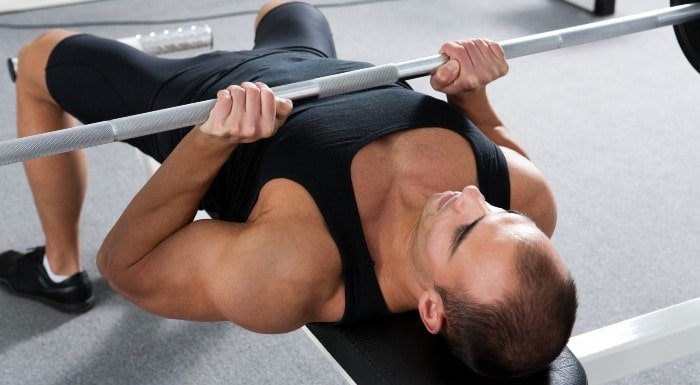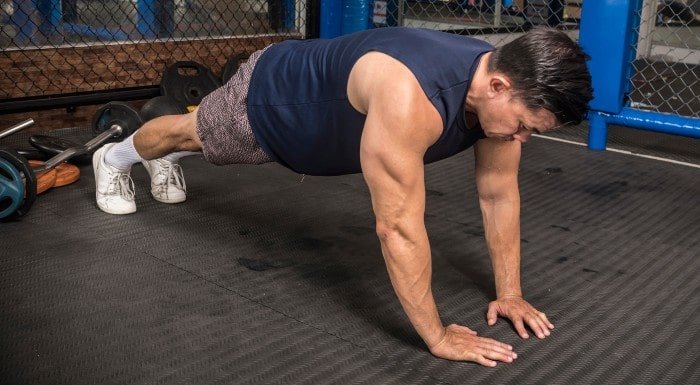In this article:
- Close Grip Bench Press Benefits
- Preparation
- Technique
- Recovery
- Common Mistakes
- Variations

In the gym, triceps training is often associated with pushdowns and other isolation movements, while muscle-building compound movements are forgotten. Compound movements are essential to muscle growth in size and strength, calorie expenditure and hormonal response. There are many more benefits, but those three alone should be enough to persuade anyone to include them in their training program.
The triceps’ three most renowned compound exercises are the close grip bench press, tricep dips, and tight grip press up. The grip positioning can instantly turn a general upper body exercise into a tricep movement by narrowing the grip. The close grip bench press is a standard flat bench: the focus is shifted from the chest and shoulders onto the triceps instead. While still incorporating the shoulders, inner chest and scapula, the majority of the muscle stimulus is placed onto the triceps. The close grip bench press is an exercise that should undoubtedly be considered for anyone looking to develop their triceps in terms of aesthetic appearance, strength, power and even athletic performance.
Close Grip Bench Press Benefits
Contribution to other compound exercises
The triceps will assist almost any upper-body exercise incorporating a push movement. For example, while the primary working muscle during the military press is the shoulder, the triceps is the secondary. Another example is during the shoulder press; the triceps causes the arm to extend and drive upwards by generating a flexion-extension at the elbow joint. Stronger triceps will make this phase of the exercise much more significant and more efficient. The close grip bench is one way to make the triceps stronger.
Less tension on the shoulders
The most common injuries drawn from the regular barbell bench press are shoulder strain and rotator cuff tear. This is due to the weak muscles in the shoulder being put under severe resistance and tension at a compromising angle. To prevent this, there should be exacting rotator cuff work to act as injury prevention and to stop this from occurring. However, the close grip bench press’s differentiated grip has a far lesser chance of shoulder injury. That said, there is considerably more tension placed on the elbow and wrist joints during the close-grip variation, so for those with previous injury history in that region, time and careful consideration should be remembered when performing this exercise.
Bigger arms
The following statement may surprise most— training biceps won’t lead to bigger arms. While biceps training has benefits, training your triceps efficiently will lead to a more rounded, aesthetic arm appearance overall. The triceps are a larger muscle group with larger muscle fibres than the biceps.
To put it simply, the biceps make up about one-third of your upper arm, while the triceps make up the remainder. If you were to walk into the gym and perform bicep curls throughout your arm session, you’d essentially be ignoring two-thirds of your arm. Find a balance but certainly never forget the triceps. Incorporating exercises such as the close grip bench press is one good way to achieve this.
Testosterone release
Including compound movements such as the close grip bench press into your training plan can have various benefits. One of these is the release of growth hormone and testosterone which can help your training and improve muscle growth and stimulation.
Target both the lateral and medial heads
While tricep pushdown and dips will target specifically the lateral head (outer) of the tricep, the close grip bench press targets both the medial (inner) and the lateral head, so it works more muscles.
The clear benefits of the close grip bench press may seem attractive, so it’s essential to ensure good technique and form. The regular bench press is the most common upper body exercise, and many people are accustomed to it, so that the close grip bench press can take some getting used to. Below is a step-by-step guide on how to perform the exercise correctly.
Preparation
- Position yourself lying down on the flat bench press. You could even perform an incline or decline method if you prefer.
- Grip the barbell applying a close grip.
- While it’s generally down to preference, a grip about shoulder-width apart is generally advised.
- Carefully un-rack the barbell and position it just above your chest.
- Ensure that your back and head are kept flat on the bench throughout the exercise.
Technique
- While inhaling your breath and keeping your close grip, gradually lower the barbell until it has come down to about chest level.
- The key to maximising tricep stimulation is by preventing elbows flaring at all times. Keep your elbows close to your torso and make the mind-muscle connection by squeezing the triceps from start to finish.
- Once you’re in this position, pause for a second before explosively pushing upwards.
- As you push the barbell back to the starting position, exhale and again, keep your elbows tucked in at all times.
- As with all exercise, form and tempo should always be considered and applied to training. For tempo on the close grip bench press, lower the weight down slowly for roughly two or three seconds, pause at the bottom for two seconds before pushing up powerfully as quickly as possible while squeezing the triceps at the same time.
- Essentially, perform slowly for the eccentric, pause and perform powerfully for the concentric.
Recovery
- Once you’ve performed this movement for the designated number of repetitions, carefully re-rack the barbell.
- It’s suggested you have a spotter or an assistant to watch you throughout the exercise.
Common Mistakes
Gripping the barbell too close
Because of the name, many people performing this exercise assume you must have your hands positioned and gripping the bar as close as possible. This is incorrect: gripping the barbell closer than roughly shoulder-width apart doesn’t recruit any more tricep fibres and increases strain on your wrist and elbow joints. For a sufficient, safe and effective grip, aim to position each hand around 7-8 inches apart or position them approximately shoulder-width apart if you don’t have your measuring stick on you at the time!
Lifting yourself off the bench
This advice applies to bench generally pressing, not just the close grip alternative. The main reason why people tend to do this is that it shortens the range of motion and makes it easier to do the repetitions. But not only is this technically performing half of the work for potentially half the results, but it also increases the risk of lower back injury. To prevent this, constantly remind yourself to keep your backside on the bench. To make the most of your workout, always prioritise good form…
Flaring the elbows
Not only will flaring your elbows to the side minimise triceps activation, but it will also maximise the potential for a shoulder injury. Prevent this by keeping your elbows tucked into your side at all times. While the angle you tuck your elbows in will depend mainly on your arm/shoulder-length, constantly focus on bringing them into your torso as much as possible. It may also help to record a video of yourself lifting, so you can see your technique or show a training partner for some advice…
Excessive warm-up sets
With any compound movement, it’s suggested we perform warm-up sets to prepare the working muscles for exercise, practise proper form, and get blood to the active muscles. But how many warm-up sets is too much? Sometimes we find ourselves taking ourselves past the point of fatigue! This is highly relevant with the bench press and its variations (close grip). Ensure you properly structure your warm-up sets and don’t fail each group — leave that to the working locations!
Grip method
Thumb positioning can significantly influence how equipment is gripped while bench pressing and for many other upper body movements, whether dumbbells, barbells, machines, etc.
However, this can be a rather dangerous technique to use when performing a risky free-weight exercise, with the weight placed over your head.
One grip that many people like to use is the thumbless grip. Not using the thumb allows some people to have a more comfortable grip and less stress on the wrist.
However, when applying serious free weight, there is potential for the barbell to slip from grasp as the thumb isn’t there to stabilise grip. Only apply the thumbless grip for weights you are comfortable with to prevent this from happening. Otherwise, use a full grip for heavyweights, and have a spotter to assist you from start to end.
Variations
You may not always get on to the correct equipment to do this exercise, so take a look at the following variations to fulfil your workout.
Close grip dumbbell press
- Very similar to the close grip bench press exercises.
- Replace the barbell with two dumbbells.
- At first it may feel more difficult that you have to control each hand through the movement.
- If it is difficult to control, rest the dumbbells against each other in the movement for more stability.
Dips

Training
How To Do Tricep Dips
Dips are simple. But they’re effective.
a year ago • By Scott Whitney
- Adjust the bars to an appropriate height (you must be able to mount/dismount safely) with the space between them around shoulder-width apart.
- Place the heel of your hand on each of the bars, with your palms facing towards your body.
- Start at the top, with your elbows locked out (shoulders over elbows, over wrists).
- Lower yourself in a controlled manner until your upper arm is parallel (or slightly further than parallel if you’re mobile enough) to the ground.
- Without swinging or kicking your legs, press yourself back up to the starting position, locking your elbows out at the top again before initiating the following reps.
Close grip push up

- Get down into a press-up position with your hands placed just under or slightly narrower than shoulder-width apart.
- Lower your body until your chest is an inch from the ground then explosively drive up by fully extending your arms.


